Been lurking on the forum behind the scenes since I had the pool built. Love the community and the wealth of information. This site has made my life much easier in terms of balancing the pool's chemistry. When the pool was finished, the pool builder had a rep do the chemicals for the first month. They were adamant to have their guy do the chemistry and not me since it was crucial in the first month. I brushed the plaster 2-3x per day for the first month. Here is a timeline of the pool.
Plaster is French Gray with quartz added.
Pictures were taken same day the plaster was installed and an hour before the water truck came to fill the pool. The plaster company highly recommended to have a water company fill the pool as I went with color plaster. This was Dec 2022.
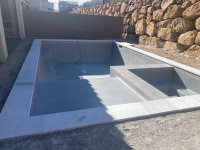
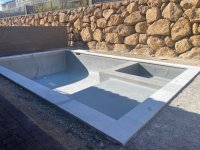
Two days after the pool was filled, the plaster started to discolor immediately. In the photos, you can see the stark contrast of the plaster on the bottom of the pool compared to the sides. The bottom was significantly lighter than the sides. I informed the pool builder and they told me to continue to brush the plaster 2x per day for the first month. As time went on, it continued getting worse.
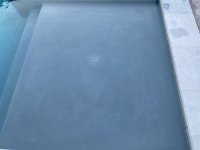
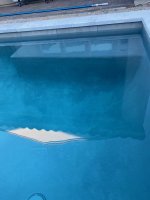
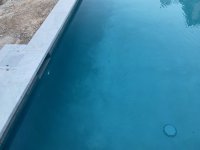
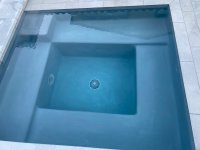
Fast forward to today, 8 1/2 month post pool completion. The plaster continued looking worse. Throughout this time, the plaster began being rough, almost like sandpaper (not all locations, but a decent amount of the plaster). I'm very disappointed with the current state. I feel horrible paying a lot for this pool with all the military deployments I had to endure to save money.


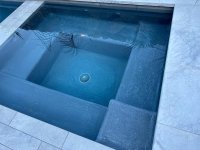
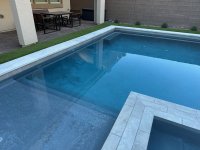
I was finally able to get both the pool builder and plaster company to come check out the pool. I did some digging on the forum beforehand and brought it up to the plaster rep. I brought up the possible use of calcium chloride being added, organic color dye, hard troweling, or the possibility of incorrect water/cement ratio for the plaster. He had no idea what organic/inorganic, colorfast/non colorfast dyes were. He just said they use liquid dye. He beat around the bush on all these matters and chalked it up to "this is normal when it comes to all color plaster" and brought up the NPC articles about water chemistry. Of course NPC will back up PBs and plaster companies and put the onus on the customer. He mentioned I had mottling because the calcium was being "sucked" out of the plaster. I had a feeling he was going to resort to those defenses. I knew my situation would be a back and forth matter with no end in sight. I told him I understood color plaster would never look 100% and I just want to be happy. I wasn't expecting a total chip out and new plaster application. At that point, they agreed to something about it.
-Here is my chemistry results on 04Feb:
-When I finally received my TF-100 pro test kit
-If it helps, I live in Las Vegas. The SWG wasn't in use as the water temp was too cold.
-My PH was extremely unstable. I would bring down the PH to around 7.4-7.5 and no joke, 2-3 days later, it would be back above 8.2/8.2+
PH: 8.2+
TA: 130
FC: 2.5
CC: 0
CYA: 30
Hardness: 550
Salt: 3,600
-12 Aug test results:
-PH is still very unstable. I probably used 8-10 gallons of muriatic acid and by TA has only dropped 20
-Did not add any salt. Maybe it went up since temps are a lot higher now in the summer
PH: 8.2+
TA: 110
FC: 8
CC: 0
CYA: 70
Hardness: 675
Salt: 4,000
What do you think is going on with my plaster and what were the factors? Not sure if it's mottling, etching, or both.
My main concern is to get the plaster color as good as possible and to smooth out the rough areas. What are my best options? Is it sanding/polishing? Acid treatment? Or both sanding/polishing and an acid treatment. The plaster company proposed that they polish the plaster and follow it up with an acid treatment. Does that seem like a good course of action or should they do an acid treatment before polishing? Or just polish the plaster and leave out the acid treatment all together? Would appreciate any info and guidance!
Regards,
Chris
Plaster is French Gray with quartz added.
Pictures were taken same day the plaster was installed and an hour before the water truck came to fill the pool. The plaster company highly recommended to have a water company fill the pool as I went with color plaster. This was Dec 2022.


Two days after the pool was filled, the plaster started to discolor immediately. In the photos, you can see the stark contrast of the plaster on the bottom of the pool compared to the sides. The bottom was significantly lighter than the sides. I informed the pool builder and they told me to continue to brush the plaster 2x per day for the first month. As time went on, it continued getting worse.




Fast forward to today, 8 1/2 month post pool completion. The plaster continued looking worse. Throughout this time, the plaster began being rough, almost like sandpaper (not all locations, but a decent amount of the plaster). I'm very disappointed with the current state. I feel horrible paying a lot for this pool with all the military deployments I had to endure to save money.




I was finally able to get both the pool builder and plaster company to come check out the pool. I did some digging on the forum beforehand and brought it up to the plaster rep. I brought up the possible use of calcium chloride being added, organic color dye, hard troweling, or the possibility of incorrect water/cement ratio for the plaster. He had no idea what organic/inorganic, colorfast/non colorfast dyes were. He just said they use liquid dye. He beat around the bush on all these matters and chalked it up to "this is normal when it comes to all color plaster" and brought up the NPC articles about water chemistry. Of course NPC will back up PBs and plaster companies and put the onus on the customer. He mentioned I had mottling because the calcium was being "sucked" out of the plaster. I had a feeling he was going to resort to those defenses. I knew my situation would be a back and forth matter with no end in sight. I told him I understood color plaster would never look 100% and I just want to be happy. I wasn't expecting a total chip out and new plaster application. At that point, they agreed to something about it.
-Here is my chemistry results on 04Feb:
-When I finally received my TF-100 pro test kit
-If it helps, I live in Las Vegas. The SWG wasn't in use as the water temp was too cold.
-My PH was extremely unstable. I would bring down the PH to around 7.4-7.5 and no joke, 2-3 days later, it would be back above 8.2/8.2+
PH: 8.2+
TA: 130
FC: 2.5
CC: 0
CYA: 30
Hardness: 550
Salt: 3,600
-12 Aug test results:
-PH is still very unstable. I probably used 8-10 gallons of muriatic acid and by TA has only dropped 20
-Did not add any salt. Maybe it went up since temps are a lot higher now in the summer
PH: 8.2+
TA: 110
FC: 8
CC: 0
CYA: 70
Hardness: 675
Salt: 4,000
What do you think is going on with my plaster and what were the factors? Not sure if it's mottling, etching, or both.
My main concern is to get the plaster color as good as possible and to smooth out the rough areas. What are my best options? Is it sanding/polishing? Acid treatment? Or both sanding/polishing and an acid treatment. The plaster company proposed that they polish the plaster and follow it up with an acid treatment. Does that seem like a good course of action or should they do an acid treatment before polishing? Or just polish the plaster and leave out the acid treatment all together? Would appreciate any info and guidance!
Regards,
Chris

